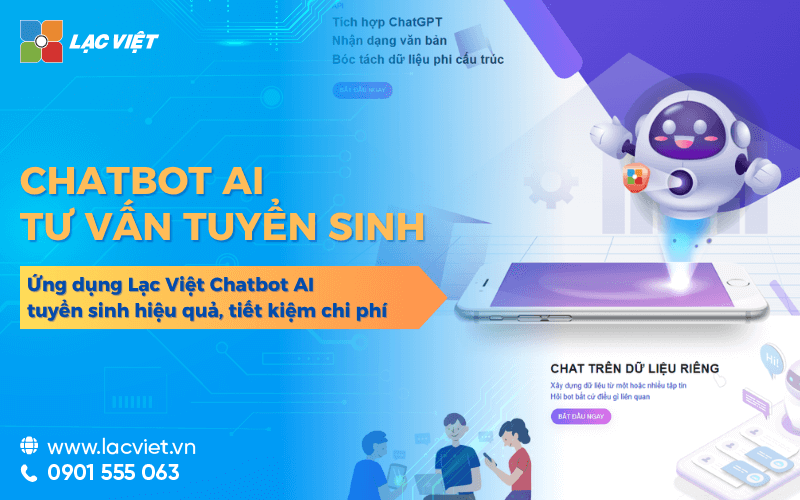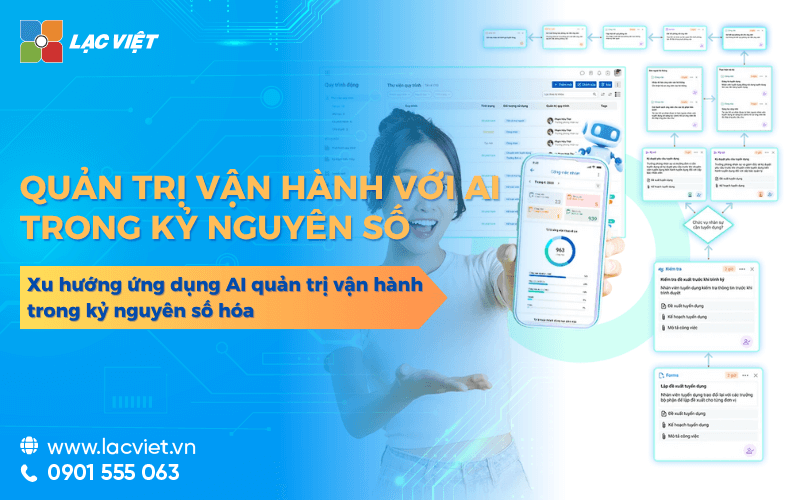Artificial intelligence (AI) are creating waves of change strong in many areas from health care and finance to retail and education. In business, AI used to be known mostly through the app as chatbot customer support tools, data analytics or automation system task simple. However, in the recent times, a generation app new AI has emerged is that AI agents.
Convert from chatbot single task to AI agents multitasking marked shift strategy in the way businesses approach technology. Instead of just “automation” job, AI agents to help businesses “reduce the load human” in the stitches need coordination between the system and process.
So AI Agents what is it? Components, how it works out? App how to operate the business brings optimal performance the most? The same Lac Viet Computing find out details in this article.
1. AI agents what is it?
AI agent is a system of AI have the ability to receive targeted, proactive, take action and regulate behavior over time instead of only feedback device, such as chatbot or automated tools traditional culture.
Different with these tools AI traditional capital only do a good job fixed, AI agents are designed to act like a “virtual employee” have the ability to receive objective to analyze the situation, plan of action even learn to improve performance over time. This is no longer assigned to a fixed task that is given to it a role.
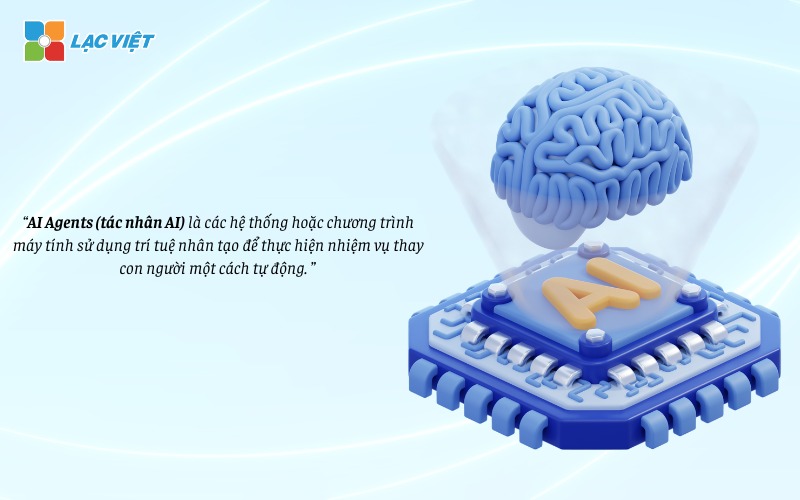
Learn a simple way, if the chatbot is the secretary, who answer only when you ask questions, then AI the agent is an employee proactive when assigned task, it will self-learn, plan, and then complete the work in a flexible way. AI agent completely different with the tool just says “get command – execution – stop”.
Highlights of AI agents:
- Have specific goals: AI agent is assigned a “mission end” (for example: preparation of financial statements), not only is each small operation in retail.
- In action: the System decide the steps to take can analyze data, look up information, submit a request or connect with other software.
- Adapt to context: Not only follow the script fixed AI agent that can flexibly handle the situation arises or is not yet in precedent.
- Learning through experience: Thanks to the integrated machine learning algorithms, AI is increasingly improving work efficiency through feedback, errors or success in the past.
Distinguish AI Agent and Chatbot
Although all AI Agents and Chatbot are developed based on AI technology, however 2 this concept has distinct differences:
- Chatbot: primarily focused on communicating with the user through text or voice, they generally act according to the script, or data has been programmed.
- AI Agents: Is hnetwork more complex, capable of decisions, and perform actions in order to achieve specific goals. The system not only to communicate but also to perform tasks such as analyzing data, predict trends, or process management.
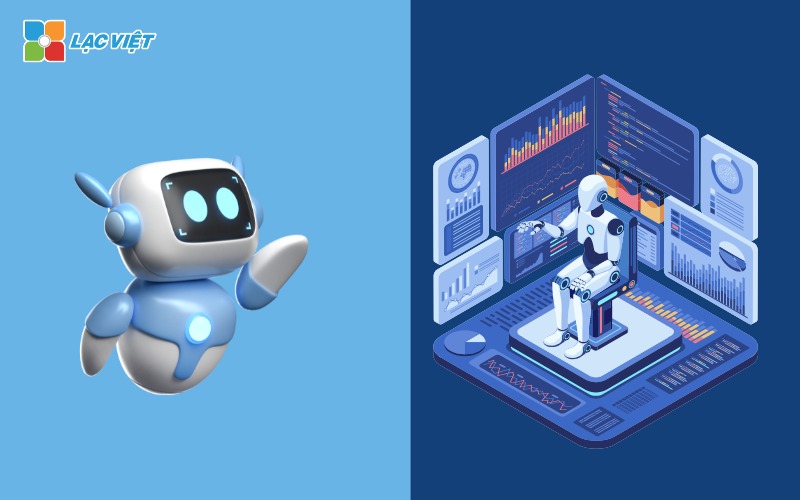
For example, A chatbot can assist customers to ask questions, while the AI Agent can automatically analyze shopping behavior and suggestions for suitable products.
2. The constituent components AI system agent
To be able to complete the work in an active way, an AI agent is not just intelligence but also need a “body” consists of many components work together as a complete system. Each component acts as a “functional parts” help AI agent to understand the task, planning, action, learning continuously improved.
Here are 5 core components that make up the operational capacity of an AI agent:
2.1. The pattern AI center (Core AI Model)
This is the “brain” of the AI agent place where the process of language processing, logical reasoning, decision-making and content creation. The role is to understand the target users to create, analyze input data, building answers, define action steps. Create text, email, form, or feedback depending on the specific situation
Types of popular models:
- Language models, big (Large Language Model – LLM) as GPT (OpenAI), Claude (Anthropic), Gemini (Google)
- Pattern for professional use in the field e.g. models, legal, financial, medical,...
2.2. Memory (Memory)
Other with chatbot only feedback each question individually, the AI agent should have the ability to remember to perform relevant work between multiple steps. Memory plays the same role as long-term memory of the employees help the agent is not “repeat yourself”.
Role:
- Remember the action taken earlier
- Monitor the progress of task completion
- Save information about the user, the context of work, system status
- Help AI agent to learn to improve in those times made after
For example, If you ask AI agent “General orders the week before,” and then said, “Remove the distributor's Northern” then memory to help AI understand you're talking to earlier results't need to repeat.
2.3. The ministry of planning (Planner)
This ingredient is to help AI agent moving from out goals to specific actions. Like a good employee know how to break the work to arrange the order of execution, the plan was held on the steps to complete the task.
Role:
- Analysis the goal into small steps can the action be
- Determine the order of priority logic between the steps
- Monitor and adjust plans if the situation changes
For example, The goal “to prepare financial statements month” systems can be automatically split into: retrieve data from the accounting system → filter by month → general the income and expenditure account → create chart → send email to the director.
2.4. The manipulation tool (Toolset)
Whether “intelligence” and “plan,” AI agent still need tools to actually perform tasks: email, call API, read or write data access system... This is the role of the manipulation tool.
Role:
- Perform the action command as data access, submit a request, fill out a form, save report
- Interaction with external software such as CRM, ERP, DMS, Outlook, Google Workspace...
- Can be set to the API, script, tool integration since the foundation of business
For example, AI agent can use the “Google Sheets Connector” to retrieve the data, “Email Sender” to send notices and “PDF Generator” to create financial statements.
2.5. Feedback loop (Feedback loop)
This is the mechanism that helps the AI agent self-assessment effective work, learning from errors, or user feedback, similar to the way an employee improve skills based on the feedback of the upper level or the resulting work.
Role:
- Compare actual results with the targets set out
- Recorded feedback from the user or system
- Manually adjust the action strategy in the next time
- Increase accuracy, reduce errors over time
An AI agent is not just a model AI single which is a coordinate system between thinking (model), memory, planning, action and learn.
3. Types of AI Agents most popular today
AI Agents not merely the automation tool, which we also designed with multiple levels of intelligence, ranging from the simple system response according to the rules to the complex self-learning ability and logical reasoning. Understand the type of agent AI help businesses choose the right fit technology to optimize processes and enhance performance.
Here are 7 type of agent AI most popular today, with the outstanding characteristics and practical application:
3.1 AI Agents simple reflex
AI Agents simple reflex is the type of agent most basic operation is based on the rules programmed and information input current. We do not have the ability to remember or learn from experience, so it fits just the simple tasks such as instant response according to conditions.
A typical example is the system temperature adjustment automatically, can increase or decrease the temperature in the room based on data collected from sensors. However, the major limitation of this type of AI is the lack of flexibility and the ability to predict, which makes it impossible to meet the more complex tasks.
3.2 AI Agent reflections based on the model
Other than simple reflex, AI Agents reflex-based models have the ability to predict the future state based on the model of the real world. We use the information to map or visualize the situation before you take action, help to optimize work efficiency.
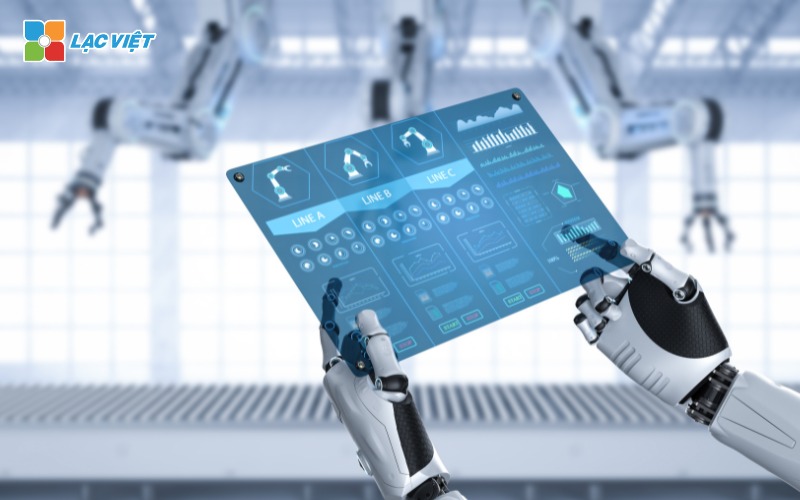
A common example is the robot vacuum cleaner smart, can build the map room and predictable roadmap for moving to a more effective cleaning. With the superior ability to calculate and optimize the type of this agent to better solve the problems need to the correct strategy.
3.3 Agents AI rely on gadgets
Agents AI rely on the utility does not simply put out of action, but also calculate the optimal level of each decision, based on the target of interest. We have the ability to analyze many different factors before bringing out the best solution.
For example, a system proposed flight tickets will intelligently compare prices, flight duration and the priority factor of the customer to take out most optimal choice. Thanks to the ability to consider multi-dimensional, type this in accordance with the commercial application requires the personalization and maximize the value for users.
3.4 AI Agent learning
AI Agent learning is the type of agent advanced has the ability to self improve performance based on data and experience accumulated. We can learn from the sample data, the self-tuning algorithm and apply the knowledge learned into practice.
Such an example practicality is the AI system, document management, capable of automatically graded profile and increasingly more accurate over each use. The strong point of this type is the ability to adapt to complex situations, and improve efficiency over time, very useful for business that handles large data volumes.
3.5 agent AI is based on desire, the intention of the user
The AI Agents based on desire, intention-designed user to understand and act according to the objectives or particular needs. We can analyze the intentions and adjust actions to meet the wishes of the user correctly.

For example, virtual assistants as Google Assistant or Siri do not simply answer the question but also can perform tasks such as set calendar, search, information, or control smart devices in the home. Thanks to the ability to respond to individual needs, the type of agent this brings interactive experience natural and more effective.
3.6 AI Agent logic
AI Agent logic with the ability to use the rules of logic to argue and make decisions in a clear, logical. This makes them especially suitable in the field requires the precise and rigorous as high as legal, medical, or financial.
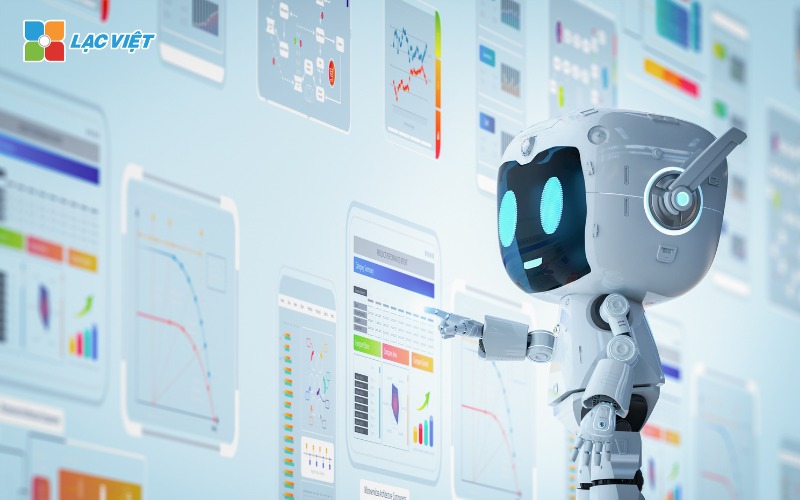
For example, in the legal system, AI logic can analyze the legal terms and take out the judgment based on evidence. With the reliable and transparent, type of agent, this role important support in the industry requires discipline, regulatory compliance.
3.7 Agents AI target
Agent AI's aim is programmed to perform one or more specific target, at the same time constantly adjust behavior based on the environment to achieve the best results. They are widely used in the industry need to manage complex as the supply chain.
For example, system supply chain management, smart use of AI to track the status of goods, the forecast demand and optimize your shipping process. Thanks to the ability to focus on goals and adaptable, flexible, type of agent, this brings great value in increasing the operational efficiency, reduce waste.
4. How AI agents operate: From the get commands to handle the task
AI agent is not merely a program that automatically follow commands. Instead, it operated as a “agents have the goal of” to be assigned a task master from which to take the steps necessary to complete the work in an active way.
To understand, we analyze each step in the process of operation of an AI agent.
Step 1. Receive target
AI agent began operations when assigned a specific target, such as:
- “General orders of the week from email clients”
- “Create comparison report-quarter sales, according to industry”
- “Reply to all support requests from customers sent to via chatbot in 24 hours”
Other with chatbot only feedback each question AI agent to receive comprehensive goal define the steps to be taken that do not require human guidance in detail each operation.
Step 2. Analysis requires environmental assessment
After the goal, the AI agent will analyze requirements, evaluate the available data and determine what is needed to perform the task:
- Learn which system are hosted data (email, CRM, Excel file...)
- Specify the data format need to be processed (text, tables, JSON...)
- Check the access connections with internal systems (ERP, CRM, DMS...)
Here is the step “prepare for action” similar to a staff consider yourself to have full documentation, access, tools or not.
Step 3. Action plan
Based on initial analysis, the AI agent will determine the steps to take:
- Send a request to retrieve data from the email or API
- Classified information, processing the data table or filter the information according to conditions
- Create reports, save the file to the specified folder
- Send notifications to people in charge via email or chat system
Note: no need for programmers writing available step by step. AI agent plan according to the objectives, context and available data.
Step 4. Take action
This is step AI agent real-time interaction with enterprise systems:
- Call API from CRM software to get a list of customers
- Search email contains the keyword “order”, extract information application form
- Enter data into the accounting system via API or file format standard
- Send your report to the person in charge or store documents into the DMS
AI agent acts as a “who operated digital” actively interact with the system in which businesses are using.
Step 5. Learning improvement
After each implementation, the AI agent has the ability to:
- Save the results and experience withdrawal if errors occur
- Get feedback from users to adjust the behavior for next time
- To improve performance based on historical operating
Examples illustrate the fact: If an AI agent enter the wrong code product by email format changes, it can be programmed to record bugs, learn how to identify email template new the next time will not repeat such errors.
5. Types of AI agents in popularity and the possibility of application in business
Depending on the target model operated, the business can choose many types of AI agent different – each designed to solve a group of specialized tasks. The important thing is not located in the application as much as possible that is the right choice AI agent for right math operated from it to optimize costs, improve productivity, bring competitive advantage.
Here are 5 group AI agents currently popular and practical application in business:
5.1. AI agents support customer service (Support Agents)
This is the kind of AI agent familiar most often found in the system, customer care center, technical support or after-sales service.
Main function:
- Automatic feedback requests (FAQ order status, error, products)
- Classification requirements according to the level of priority
- Send complex requirements to the correct parts handling
- Recorded history, exchange, update CRM
Illustrative example: When the client sends the message “I would like to know order status”, the AI agent will automatically check the logistics system response accurately within a few seconds instead of waiting staff live support.
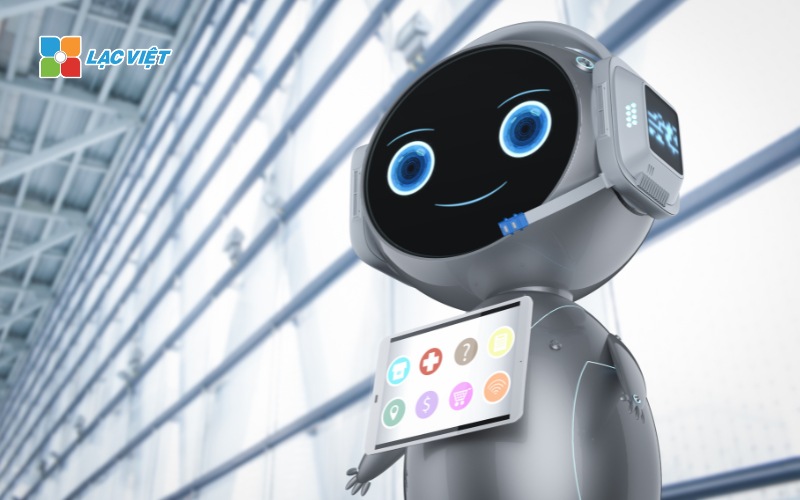
Enterprise value received:
- Speed feedback
- Reduce the pressure for our team of customer care
- Enhance customer experience, increase retention
5.2. AI agents, data analysis, proposal strategy (Data Analyst Agents)
Instead of asking the analytical department send a report every week, business can be assigned to AI agent role aggregated data analysis proposed action in an automated way.
Main function:
- Access data from multiple sources: CRM, ERP, spreadsheets, Google Analytics
- Trend analysis, abnormality, or performance according to KPIS
- Suggests improvements to process, adjust the goal or risk warning
Illustrative example: An AI agent can analyze sales data by region, detection, sales in the South decreased continuously for 3 weeks and hints of marketing manager tuning promotion campaign in this area.
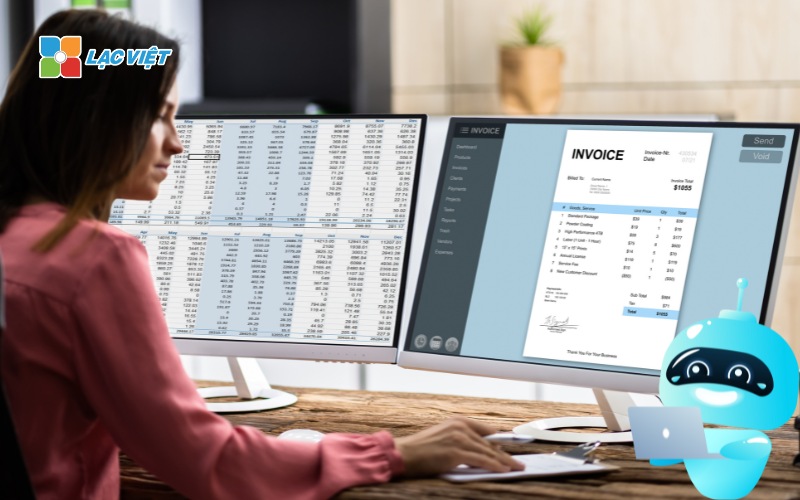
Enterprise value received:
- A decision fast data base
- Timely warning of the risk of business
- Save time create report presents data
Lac Viet Financial AI Agent to solve the “anxieties” of the business
For the accounting department:For leaders:
- Reduce workload and handle end report states such as summarizing, tax settlement, budgeting.
- Automatically generate reports, cash flow, debt collection, financial statements, details in short time.
- Provide financial picture comprehensive real-time help in quick decision making
- Support troubleshooting instant on the financial indicators, providing forecast financial strategy without waiting from the related department.
- Warning of financial risks, suggesting solutions to optimize resources.
Financial AI Agent of Lac Viet is not only a tool of financial analysis that is also a smart assistant, help businesses understand management “health” finance in a comprehensive manner. With the possibility of automation, in-depth analysis, update real-time, this is the ideal solution to the Vietnam business process optimization, financial management, strengthen competitive advantage in the market.
SIGN UP CONSULTATION AND DEMO
5.3. AI agents supported operating (Workflow Automation Agents)
This is the type of AI agent responsible for the work repeated in internal processes: data entry, system updates, send email, check the status of the contract...
Main function:
- Automate the task for the approved menu, create a form, to remind term work
- Interact with many systems (DMS, HRM, ERP...) to rotation information
- Track work progress, send alerts if it detects congestion
Illustrative example: the AI agent receiving the request purchases, reconcile inventory, create polls suggest to browse buy sent to the finance department without the need for staff to enter the hand.
Enterprise value received:
- Cut manipulate craft
- Ensure the process is smooth, reduce latency internal
- Increase work performance multi-room board
5.4. AI agents internal training (Training/Learning Agents)
In the environment of modern business, the constant training is required. AI agent can play the role of “teaching assistant digital”, to personalize content and training for each staff member.
Main function:
- Suggestions learning materials according to capacity and location work
- Create review questions or check the following courses
- Reviews the process of learning lays out a roadmap to develop the next
- Answer questions related to internal policies, workflow
Illustrative example: new employee in the company can chat with the AI agent to learn workflow, system reports, company policy, without waiting for the instructor directly.
Enterprise value received:
- Speed up integration of new employees
- Maintain continuous training, personalization
- Reduction depends on the team of the traditional
5.5. Multi-agent systems: Systems, many AI agents to coordinate as a team
At advanced levels, enterprises can deploy multiple AI agents coordinate with each other as a collecting institution, each agent in charge of a specific role together solved a big goal.
For example the coordinate system:
- 1 AI agent synthetic customer data
- 1 AI agent analyze purchase behavior
- 1 AI agent proposed package deals fit
- 1 AI agent to schedule email marketing tracking feedback
Enterprise value received:
- Automate the entire process chain related departments
- Easy to scale without increasing personnel
- Model building flexible organizations, apps, AI as a “team”virtual
According to the report of McKinsey (2024), more than 40% of big business in the Us has deployed at least one type of AI agent in the internal processes with special focus in the field of customer care, operation and data analysis.
The choice of AI agent suitable will help enterprises solve the right spot congestion in operation, optimum performance opens up opportunities automation sweeping without investment complex.
6. Using AI Agent in the business
To AI agent actually create value in an enterprise environment, a prerequisite is the ability to flexible integration with systems, software and data that businesses are using daily. One agent even smart to now will also be limited, if it works independent, not connected with the data flow, processes, internal platforms.
Therefore, the interaction between the AI agent and the enterprise system is the key element to ensure the feasibility effective when deployed.
6.1. Connect via API – bridge engineering between AI agent and business software
API (Application Programming Interface) that tool help the AI agent “communicate” with the software current as:
- CRM (Customer Relationship Management): management of customer information
- ERP (Enterprise Resource Planning): order management, finance, logistics
- DMS (Document Management System): host lookup document
- HRM (Human Resource Management): management, personnel management, internal processes
- Email Server (Gmail, Outlook): send – receive email according to the scenario
Through the API, the AI agent can retrieve data, update information, create new profile or take action in accordance rights and structure of the current system.
For example practices: AI agent received a request “to Create quotes for customers A”. The system will:
- Visit CRM to retrieve customer information
- API call ERP to get product pricing table
- Create file quotes to send email through Outlook
- Updated transaction history in CRM to business team track
6.2. User interface internal, where employees work with AI agent
AI agent not only working silently behind which can be integrated directly into the platform employees use every day, such as:
- Dashboard internal: allows users To submit requests, track the status of task, get the result handle
- The tools team communication: Slack, Microsoft Teams, Zalo OA... where AI agent can “exchange” as a team member
- App business no-code/low-code: enabling non-expert users, technical interaction with the AI agent through the form or chatbot
For example practices: On Microsoft Teams, employees can send a request like:
“Agent, I take a general order from 1-15/9 for the Central.”
AI agent will understand context, data connection and immediate feedback in the chat box or send link to download the report.
6.3. Access database shared optimize the ability to exploit available resources
Businesses today often store data scattered in many places such as Google Drive, SharePoint, Dropbox, or file system internal. AI agent should have the ability to access, search, extract data, right place, right format, right time.
For example: When receiving the request “Find a contract with ABC company year 2022”, the AI agent will:
- Access Google Drive with decentralized
- Scanned documents in PDF or Word
- Used OCR (if necessary) to search text content
- Extract the correct file contract send the request
Benefits:
- Reduce the search time material crafts
- Increased response speed in handling records, reports
- Increase the efficient use of internal data – no longer “forgotten” in the folder
The ability to interact with the system main business is creating value difference in the practice of AI agents compared to the AI engine traditions. Instead of being a separate app, AI agents act as a virtual member in the organization can use tools, data connection and collaboration with humans to complete tasks in a flexible way smart.
CONTACT INFORMATION:
- Lac Viet Computing Corporation
- Hotline: 0901 555 063 | (+84.28) 3842 3333
- Email: info@lacviet.vn – Website: https://lacviet.vn
- Headquarters: 23 Nguyen Thi Huynh, P. 8, Q. Phu Nhuan, Ho Chi Minh city




